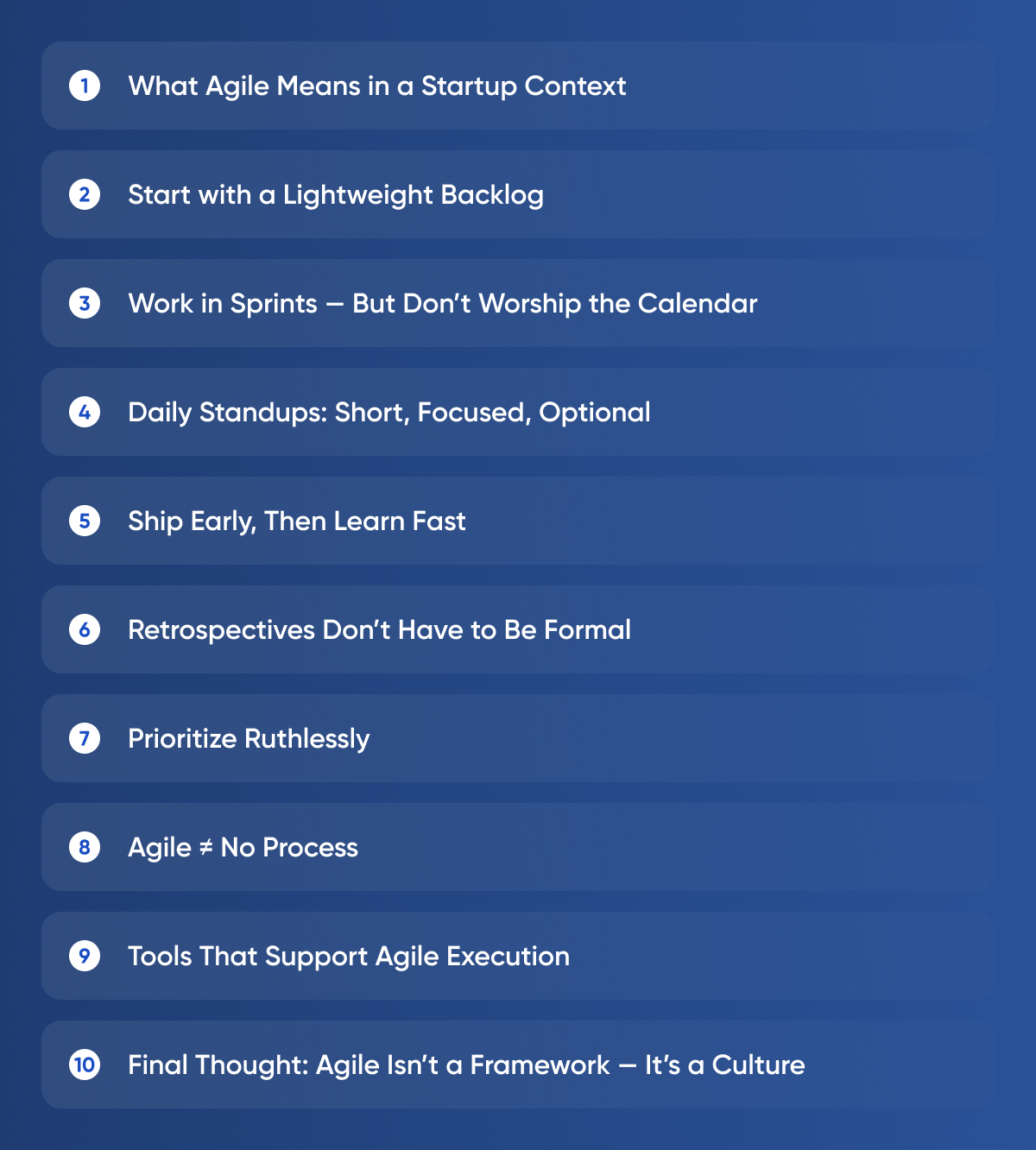Move fast and break things might sound sexy, but in 2025, the smarter play is: move fast and ship smart.
For startup teams, especially those under pressure to validate, iterate, and grow with limited resources, agile isn’t just a project management methodology — it’s a mindset. Done right, it’s the difference between a team that ships features users love, and a team that drowns in scope creep, misalignment, and tech debt.
At Movadex, we work with founders who need to launch fast, pivot even faster, and build with enough structure to scale — but not enough to slow them down. This post isn’t Agile™ with a capital A. It’s how modern startups are actually applying agile thinking to move forward with clarity and speed.

What Agile Means in a Startup Context
You’ve probably heard of Scrum, Kanban, sprints, stand-ups, retrospectives. But for most startups, Agile isn't about dogma — it’s about speed with feedback loops.
At its core, agile for startups means:
-
Short, focused sprints (1–2 weeks max)
-
Regular check-ins (not meetings for the sake of meetings)
-
Prioritization based on user value
-
Shipping usable features early and improving them over time
You’re not building a perfect roadmap. You’re building momentum — and clarity on what to build next.
Start with a Lightweight Backlog
Many startups waste time over-specifying tickets before they even validate the idea. Instead of full-blown specs, start with a lean backlog: a list of clear, user-focused problems to solve.
Use this format:
- "As a [user type], I want to [do action] so that [I achieve outcome]."
Example: "As a new user, I want to see a visual onboarding checklist so I don’t miss setup steps."
This frames features around value, not just functionality. You’ll refine the how later — with your dev and design team.
Work in Sprints — But Don’t Worship the Calendar
Sprints are useful because they create rhythm. A 1- or 2-week cadence allows your team to plan, execute, review, and adjust — without endless meetings or chaotic to-do lists.
But don’t stick to the structure at the expense of common sense. If your team is stuck debugging a blocker, don’t pretend it’ll fit into a sprint. If a feature is clearly not ready, don’t ship it just to hit a deadline.
The point of sprints is to force prioritization, not to box your team in.
Daily Standups: Short, Focused, Optional
In a startup, your whole company might be the product team. So keep standups tight:
-
What did I work on yesterday?
-
What am I doing today?
-
Any blockers?
No deep discussions. No status updates for the sake of optics. Just a pulse check. If you're async or distributed, do it via Slack.
Ship Early, Then Learn Fast
You don’t know what your users actually want until they start clicking. Don’t wait until something is “done” to get feedback.
Launch features behind toggles. Test flows with 10 beta users. Use feature flags, launch pages, or internal tools like Retool to test logic before scaling.
Early feedback = early wins (or course corrections).
Retrospectives Don’t Have to Be Formal
Every 2–3 sprints, pause and reflect:
-
What’s working?
-
What’s slowing us down?
-
What should we stop/start/continue?
Keep it real. Avoid finger-pointing. Document takeaways. Most important: actually act on the insights. Even small process tweaks (like switching from Trello to Linear or refining ticket formats) can unblock velocity.
Prioritize Ruthlessly
In early-stage startups, everything feels important. But not everything is urgent — or useful.
Prioritize features based on:
-
Will it move activation, retention, or conversion?
-
Is it blocking another key feature?
-
Can we test this without fully building it?
Use MoSCoW (Must, Should, Could, Won’t) or ICE (Impact, Confidence, Ease) to triage requests. Say no often. The roadmap is not a wishlist.
Agile ≠ No Process
One mistake founders make is thinking agile means chaos — no planning, no structure, just building as you go.
Agile isn’t an excuse to skip documentation or tech debt management. You still need ticket hygiene, clear ownership, a testing pipeline, and version control.
You’re building the plane while flying it. But you still need to check the wings.
Tools That Support Agile Execution
-
Project management: Linear, Jira, Trello, Notion
-
Code management: GitHub, GitLab
-
Feedback & insights: PostHog, FullStory, Mixpanel
-
Docs & specs: Notion, Confluence, Google Docs
Pick tools your team will actually use. Simple and consistent > fancy and forgotten.
Final Thought: Agile Isn’t a Framework — It’s a Culture
You don’t need a certified scrum master. You need a team that cares about shipping, listening, and improving.
Agile for startups means learning fast, staying lean, and removing blockers — without burying yourself in ceremonies. It’s about momentum, feedback, and trust.
At Movadex, we work with startup teams to embed agile thinking into their process from day one. Whether we’re building your v1 or supporting your sprint planning, our goal is the same: help you ship smarter, faster, and with confidence.
Agile isn’t what you call your process. It’s how you move.




